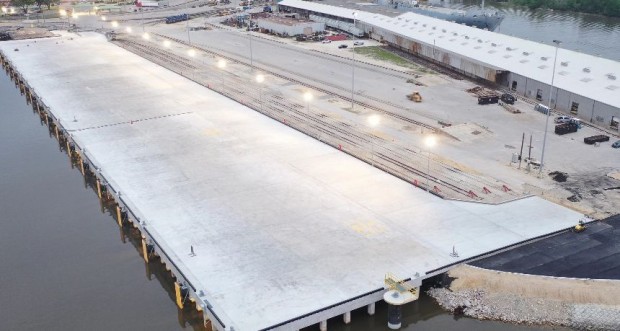Despite the challenges of underwater demolition and reconstruction, McCarthy completed the construction of the Port of Beaumont ahead of schedule. The new port boasts sustainable construction practices and a corrosion-resistant foundation, ensuring longevity and environmental responsibility.

(Photo : Baird Maritime/McCarthy Building Companies )
Construction of Main Street Terminal 1
In 2012, the concrete slab that had been part of the original pier at the Main Street Terminal for one hundred years fell into the water due to piling corrosion. These circumstances necessitated the complete demolition of the dock, with several sections remaining submerged and exhibiting almost no visibility.
By initially removing everything that was right on and slightly below the subsurface mudline, McCarthy built the new dock in the footprint of the old dock. This was reportedly necessary since any underwater obstructions would have made it more challenging to install the pile driving. As mentioned, McCarthy made use of divers in addition to an unmanned survey vehicle (USV), which allowed the divers to navigate securely and efficiently to determine its precise location under the water's surface.
Moreover, following the examination of the region, McCarthy utilized punches, which are demolition instruments that could be dropped into the water, to break up the material into bits that were easier to manage before it was removed. A pile of punches boasting a steel point was strategically inserted into the old dock to fragment it without generating surplus debris submerged. Accordingly, the port's goal was to increase its capacity to handle general cargo by more than fifteen percent, and the project required the removal of a dock structure that had failed to function correctly and the building of a new general cargo pier.
Thus, in February 2022, McCarthy commenced construction on the Main Street Terminal, which was accomplished several months ahead of schedule. The port has allocated US$57 million for its building project.
Also Read: Maximizing Space: Creative Ways to Transform Your Garage into a Gym
Sustainable Goals of the Port
The new port of Beaumont has a more significant part in the middle that measures 152 feet wide, for a total length of 1,200 feet and a width of 130 feet. The structure is built using components such as precast concrete deck panels, concrete topping slabs, cast-in-place concrete tops and beams, and concrete piles. In addition to installing the concrete and piles, McCarthy was responsible for installing the utilities, including the water and sewer systems.
As stated, sustainability and resilience were at the forefront of the Port of Beaumont's minds when they considered the possibility of revamping the terminal. Concrete piles, which offer a foundation that is resistant to corrosion and provides longer resilience, were among the essential architectural materials.
In addition, a final concrete topping slab was made utilizing synthetic concrete reinforcing fibers instead of the conventional welded steel wire mesh. Dealing with a corrosion-resistant surface for this reinforcing material will slow deterioration. An energy-absorbing component is incorporated into the new Fender system. This component will lessen the loads placed on the dock, resulting in an extension of the new dock's usable life.
Related Article: Georgia Tech's New Athletic Performance Center Embraces Sustainable Construction







